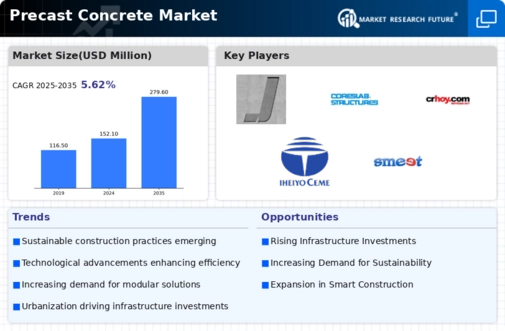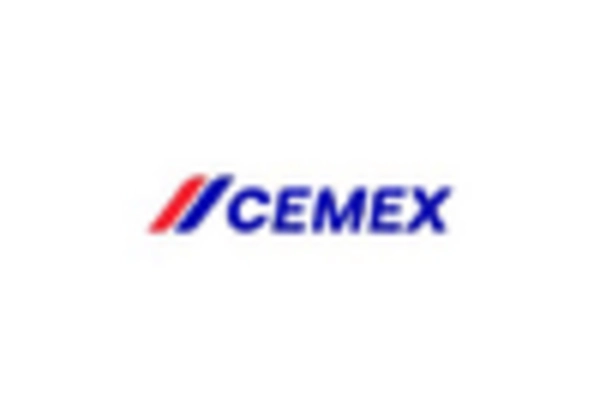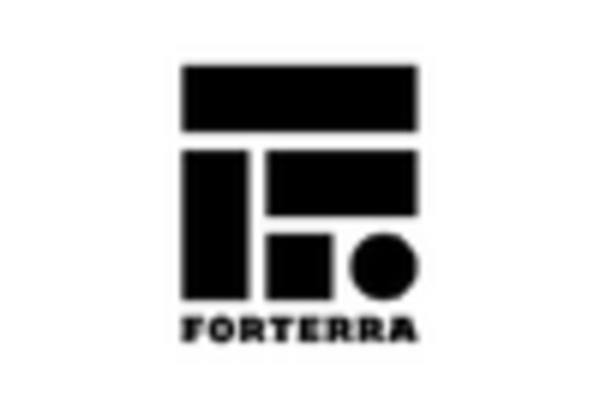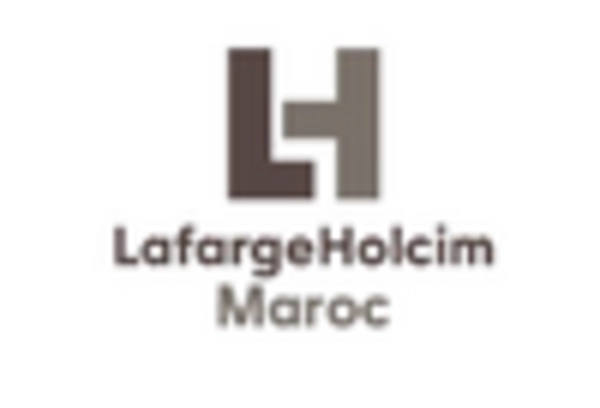-
Market Introduction
-
Definition 19
-
Scope of the Study 19
-
Market Structure 20
-
Key Takeaways 20
-
Macro Factor Indicators Analysis 20
-
List of Assumptions 21
-
Research Methodology
-
Research Process 23
-
Primary Research 24
-
Secondary Research 25
-
Market Size Estimation 25
-
Forecast Model 26
-
Market Dynamics
-
Introduction 28
-
Drivers 28
- Increasing Investment in Construction Industry 28
- Urbanization leading to Rise in Construction Activities 30
- Reduced Construction Waste 30
- Drivers Impact Analysis 31
-
Restraints 31
- Economic Downturn in Major Regions 31
- Fluctuating Raw Material Prices 31
- Restraints Impact Analysis 32
-
Opportunity 32
- Scope in Emerging Economies 32
-
Market Factor Analysis
-
Supply Chain Analysis 34
- Design and Development 34
- Raw Material Supply 34
- Precast Concrete Manufacturing 34
- Distribution 35
- End-Use 35
-
Porter’s Five Forces Model 35
- Threat of New Entrants 35
- Bargaining Power of Suppliers 36
- Bargaining Power of Buyers 36
- Threat of Substitutes 36
- Intensity of Rivalry 36
- Threat of Substitutes 36
- Rivalry 36
-
Import Analysis of Refractory cements, mortars, concretes and similar compositions 37
-
Export Analysis of Refractory cements, mortars, concretes and similar compositions 38
-
Global Precast concrete Market, By Product
-
Overview 41
- Columns & Beams 43
- Floors & Roofs 43
- Walls 43
- Stairs and Landings 44
- Others 44
-
Global Precast Concrete Market, By Application
-
Overview 46
- Structural Components 47
- Architectural Components 47
- Bridge Components 47
- Others 47
-
Global Precast concrete Market, By End-use
-
Overview 49
- Residential 50
- Non-Residential 50
- Agriculture 50
-
Global Precast Concrete Market, By Region
-
Overview 52
-
North America 54
- US 58
- Canada 61
-
Europe 64
- Germany 68
- UK 72
- France 75
- Spain 78
- Rest of Europe 81
-
Asia-Pacific 84
- China 88
- Japan 92
- India 95
- Rest of Asia Pacific 99
-
Rest of the World 102
- Middle East and Africa 106
-
Latin America 109
-
Competitive Landscape
-
Competitive Scenario 114
- Market Share Analysis 115
- Competitive BENCHMARKING OF MAJOR COMPETITORS 116
-
Company Profiles
-
Metromont Corporation 118
- Company Overview 118
- Financial Overview 118
- Products Offered 118
- Key Developments (2020-2027) 119
- SWOT Analysis 119
- Key Strategies 119
-
Coreslab Structures 120
- Company Overview 120
- Financial Overview 120
- Products Offered 120
- Key Developments (2020-2027) 121
- SWOT Analysis 121
- Key Strategies 122
-
CRH 122
- Company Overview 122
- Financial Overview 122
- Products Offered 123
- Key Developments (2015 – 2018) 123
- SWOT Analysis 124
- Key Strategies 124
-
Coltman Precast Concrete Limited 125
- Company Overview 125
- Financial Overview 125
- Products Offered 125
- Key Developments (2020-2027) 125
- SWOT Analysis 126
- Key Strategies 126
-
HEIDELBERGCEMENT AG 127
- Company Overview 127
- Financial Overview 127
- Products Offered 128
- Key Developments (2020-2027) 129
- SWOT Analysis 129
- Key Strategies 129
-
TAIHEIYO CEMENT CORPORATION 130
- Company Overview 130
- Financial Overview 130
- Products Offered 131
- Key Developments (2020-2027) 132
- SWOT Analysis 132
- Key Strategies 132
-
SMEET 133
- Company Overview 133
- Financial Overview 133
- Products Offered 133
- Key Developments (2020-2027) 133
- SWOT Analysis 134
- Key Strategies 134
-
LARSEN & TOUBRO LIMITED 135
- Company Overview 135
- Financial Overview 135
- Products Offered 136
- Key Developments (2020-2027) 137
- SWOT Analysis 137
- Key Strategies 137
-
Jensen Precast 138
- Company Overview 138
- Financial Overview 138
- Products Offered 138
- Key Developments (2020-2027) 138
- SWOT Analysis 139
- Key Strategies 139
-
SKANSKA AB 140
- Company Overview 140
- Financial Overview 140
- Products Offered 141
- Key Developments (2020-2027) 141
- SWOT Analysis 141
- Key Strategies 142
-
Tindall Corporation 142
- Company Overview 142
- Financial Overview 142
- Products Offered 142
- Key Developments (2020-2027) 143
- SWOT Analysis 143
- Key Strategies 143
-
Molin Concrete Products Company, Inc. 144
- Company Overview 144
- Financial Overview 144
- Products Offered 144
- Key Developments 145
- SWOT Analysis 145
- Key Strategies 145
-
-
List of Tables
-
MARKET SYNOPSIS 17
-
LIST OF ASSUMPTIONS 21
-
SHARE OF TOP FIVE COUNTRIES ATTRACTING FDI EQUITY INFLOWS FOR CONSTRUCTION DEVELOPMENT, 2020-2027 (USD MILLION) 29
-
FDI INFLOWS, ASIA-PACIFIC, 2020-2027 (USD BILLION) 30
-
NORTH AMERICA: IMPORTS, 2020-2027 (USD THOUSAND) 37
-
EUROPE: IMPORTS, 2020-2027 (USD THOUSAND) 37
-
ASIA PACIFIC: IMPORTS, 2020-2027 (USD THOUSAND) 37
-
REST OF THE WORLD (ROW): IMPORTS, 2020-2027 (USD THOUSAND) 38
-
NORTH AMERICA: EXPORTS, 2020-2027 (USD THOUSAND) 38
-
EUROPE: EXPORTS, 2020-2027 (USD THOUSAND) 39
-
ASIA PACIFIC: EXPORTS, 2020-2027 (USD THOUSAND) 39
-
REST OF THE WORLD (ROW): EXPORTS, 2020-2027 (USD THOUSAND) 39
-
GLOBAL PRECAST CONCRETE MARKET, BY PRODUCT, 2020-2027 (USD MILLION) 41
-
GLOBAL PRECAST CONCRETE MARKET, BY PRODUCT, 2020-2027 (MILLION TONNES) 41
-
WALLS: GLOBAL PRECAST CONCRETE MARKET, BY TYPE, 2020-2027 (USD MILLION) 42
-
WALLS: GLOBAL PRECAST CONCRETE MARKET, BY TYPE, 2020-2027 (MILLION TONNES) 42
-
GLOBAL PRECAST CONCRETE MARKET, BY APPLICATION, 2020-2027 (USD MILLION) 46
-
GLOBAL PRECAST CONCRETE MARKET, BY APPLICATION, 2020-2027 (MILLION TONNES) 46
-
GLOBAL PRECAST CONCRETE MARKET, BY END-USE, 2020-2027 (USD MILLION) 49
-
GLOBAL PRECAST CONCRETE MARKET, BY END-USE, 2020-2027 (MILLION TONNES) 49
-
GLOBAL PRECAST CONCRETE MARKET, BY REGION, 2020-2027 (USD MILLION) 52
-
GLOBAL PRECAST CONCRETE MARKET, BY REGION, 2020-2027 (MILLION TONNES) 53
-
NORTH AMERICA: PRECAST CONCRETE MARKET, BY COUNTRY, 2020-2027 (USD MILLION) 54
-
NORTH AMERICA: PRECAST CONCRETE MARKET, BY COUNTRY, 2020-2027 (MILLION TONNES) 54
-
NORTH AMERICA: PRECAST CONCRETE MARKET, BY PRODUCT, 2020-2027 (USD MILLION) 55
-
NORTH AMERICA: PRECAST CONCRETE MARKET, BY PRODUCT, 2020-2027 (MILLION TONNES) 55
-
WALLS: NORTH AMERICA: PRECAST CONCRETE MARKET, BY TYPE, 2020-2027 (USD MILLION) 56
-
WALLS: NORTH AMERICA: PRECAST CONCRETE MARKET, BY TYPE, 2020-2027 (MILLION TONNES) 56
-
NORTH AMERICA: PRECAST CONCRETE MARKET, BY APPLICATION, 2020-2027 (USD MILLION) 56
-
NORTH AMERICA: PRECAST CONCRETE MARKET, BY APPLICATION, 2020-2027 (MILLION TONNES) 57
-
NORTH AMERICA: PRECAST CONCRETE MARKET, BY END-USE, 2020-2027 (USD MILLION) 57
-
NORTH AMERICA: PRECAST CONCRETE MARKET, BY END-USE, 2020-2027 (MILLION TONNES) 57
-
US: PRECAST CONCRETE MARKET, BY PRODUCT, 2020-2027 (USD MILLION) 58
-
US: PRECAST CONCRETE MARKET, BY PRODUCT, 2020-2027 (MILLION TONNES) 58
-
WALLS: US: PRECAST CONCRETE MARKET, BY TYPE, 2020-2027 (USD MILLION) 59
-
WALLS: US: PRECAST CONCRETE MARKET, BY TYPE, 2020-2027 (MILLION TONNES) 59
-
US: PRECAST CONCRETE MARKET, BY APPLICATION, 2020-2027 (USD MILLION) 59
-
US: PRECAST CONCRETE MARKET, BY APPLICATION, 2020-2027 (MILLION TONNES) 60
-
US: PRECAST CONCRETE MARKET, BY END-USE, 2020-2027 (USD MILLION) 60
-
US: PRECAST CONCRETE MARKET, BY END-USE, 2020-2027 (MILLION TONNES) 60
-
CANADA: PRECAST CONCRETE MARKET, BY PRODUCT, 2020-2027 (USD MILLION) 61
-
CANADA: PRECAST CONCRETE MARKET, BY PRODUCT, 2020-2027 (MILLION TONNES) 61
-
WALLS: CANADA: PRECAST CONCRETE MARKET, BY TYPE, 2020-2027 (USD MILLION) 62
-
WALLS: CANADA: PRECAST CONCRETE MARKET, BY TYPE, 2020-2027 (MILLION TONNES) 62
-
CANADA: PRECAST CONCRETE MARKET, BY APPLICATION, 2020-2027 (USD MILLION) 62
-
CANADA: PRECAST CONCRETE MARKET, BY APPLICATION, 2020-2027 (MILLION TONNES) 63
-
CANADA: PRECAST CONCRETE MARKET, BY END-USE, 2020-2027 (USD MILLION) 63
-
CANADA: PRECAST CONCRETE MARKET, BY END-USE, 2020-2027 (MILLION TONNES) 63
-
EUROPE: PRECAST CONCRETE MARKET, BY COUNTRY, 2020-2027 (USD MILLION) 64
-
EUROPE: PRECAST CONCRETE MARKET, BY COUNTRY, 2020-2027 (MILLION TONNES) 65
-
EUROPE: PRECAST CONCRETE MARKET, BY PRODUCT, 2020-2027 (USD MILLION) 65
-
EUROPE: PRECAST CONCRETE MARKET, BY PRODUCT, 2020-2027 (MILLION TONNES) 66
-
WALLS: EUROPE: PRECAST CONCRETE MARKET, BY TYPE, 2020-2027 (USD MILLION) 66
-
WALLS: EUROPE: PRECAST CONCRETE MARKET, BY TYPE, 2020-2027 (MILLION TONNES) 66
-
EUROPE: PRECAST CONCRETE MARKET, BY APPLICATION, 2020-2027 (USD MILLION) 67
-
EUROPE: PRECAST CONCRETE MARKET, BY APPLICATION, 2020-2027 (MILLION TONNES) 67
-
EUROPE: PRECAST CONCRETE MARKET, BY END-USE, 2020-2027 (USD MILLION) 68
-
EUROPE: PRECAST CONCRETE MARKET, BY END-USE, 2020-2027 (MILLION TONNES) 68
-
GERMANY: PRECAST CONCRETE MARKET, BY PRODUCT, 2020-2027 (USD MILLION) 69
-
GERMANY: PRECAST CONCRETE MARKET, BY PRODUCT, 2020-2027 (MILLION TONNES) 69
-
WALLS: GERMANY: PRECAST CONCRETE MARKET, BY TYPE, 2020-2027 (USD MILLION) 69
-
WALLS: GERMANY: PRECAST CONCRETE MARKET, BY TYPE, 2020-2027 (MILLION TONNES) 70
-
GERMANY: PRECAST CONCRETE MARKET, BY APPLICATION, 2020-2027 (USD MILLION) 70
-
GERMANY: PRECAST CONCRETE MARKET, BY APPLICATION, 2020-2027 (MILLION TONNES) 71
-
GERMANY: PRECAST CONCRETE MARKET, BY END-USE, 2020-2027 (USD MILLION) 71
-
GERMANY: PRECAST CONCRETE MARKET, BY END-USE, 2020-2027 (MILLION TONNES) 71
-
UK: PRECAST CONCRETE MARKET, BY PRODUCT, 2020-2027 (USD MILLION) 72
-
UK: PRECAST CONCRETE MARKET, BY PRODUCT, 2020-2027 (MILLION TONNES) 72
-
WALLS: UK: PRECAST CONCRETE MARKET, BY TYPE, 2020-2027 (USD MILLION) 73
-
WALLS: UK: PRECAST CONCRETE MARKET, BY TYPE, 2020-2027 (MILLION TONNES) 73
-
UK: PRECAST CONCRETE MARKET, BY APPLICATION, 2020-2027 (USD MILLION) 73
-
UK: PRECAST CONCRETE MARKET, BY APPLICATION, 2020-2027 (MILLION TONNES) 74
-
UK: PRECAST CONCRETE MARKET, BY END-USE, 2020-2027 (USD MILLION) 74
-
UK: PRECAST CONCRETE MARKET, BY END-USE, 2020-2027 (MILLION TONNES) 74
-
FRANCE: PRECAST CONCRETE MARKET, BY PRODUCT, 2020-2027 (USD MILLION) 75
-
FRANCE: PRECAST CONCRETE MARKET, BY PRODUCT, 2020-2027 (MILLION TONNES) 75
-
WALLS: FRANCE: PRECAST CONCRETE MARKET, BY TYPE, 2020-2027 (USD MILLION) 76
-
WALLS: FRANCE: PRECAST CONCRETE MARKET, BY TYPE, 2020-2027 (MILLION TONNES) 76
-
FRANCE: PRECAST CONCRETE MARKET, BY APPLICATION, 2020-2027 (USD MILLION) 76
-
FRANCE: PRECAST CONCRETE MARKET, BY APPLICATION, 2020-2027 (MILLION TONNES) 77
-
FRANCE: PRECAST CONCRETE MARKET, BY END-USE, 2020-2027 (USD MILLION) 77
-
FRANCE: PRECAST CONCRETE MARKET, BY END-USE, 2020-2027 (MILLION TONNES) 77
-
SPAIN: PRECAST CONCRETE MARKET, BY PRODUCT, 2020-2027 (USD MILLION) 78
-
SPAIN: PRECAST CONCRETE MARKET, BY PRODUCT, 2020-2027 (MILLION TONNES) 78
-
WALLS: SPAIN: PRECAST CONCRETE MARKET, BY TYPE, 2020-2027 (USD MILLION) 79
-
WALLS: SPAIN: PRECAST CONCRETE MARKET, BY TYPE, 2020-2027 (MILLION TONNES) 79
-
SPAIN: PRECAST CONCRETE MARKET, BY APPLICATION, 2020-2027 (USD MILLION) 79
-
SPAIN: PRECAST CONCRETE MARKET, BY APPLICATION, 2020-2027 (MILLION TONNES) 80
-
SPAIN: PRECAST CONCRETE MARKET, BY END-USE, 2020-2027 (USD MILLION) 80
-
SPAIN: PRECAST CONCRETE MARKET, BY END-USE, 2020-2027 (MILLION TONNES) 80
-
REST OF EUROPE: PRECAST CONCRETE MARKET, BY PRODUCT, 2020-2027 (USD MILLION) 81
-
REST OF EUROPE: PRECAST CONCRETE MARKET, BY PRODUCT, 2020-2027 (MILLION TONNES) 81
-
WALLS: REST OF EUROPE: PRECAST CONCRETE MARKET, BY TYPE, 2020-2027 (USD MILLION) 82
-
WALLS: REST OF EUROPE: PRECAST CONCRETE MARKET, BY TYPE, 2020-2027 (MILLION TONNES) 82
-
REST OF EUROPE: PRECAST CONCRETE MARKET, BY APPLICATION, 2020-2027 (USD MILLION) 82
-
REST OF EUROPE: PRECAST CONCRETE MARKET, BY APPLICATION, 2020-2027 (MILLION TONNES) 83
-
REST OF EUROPE: PRECAST CONCRETE MARKET, BY END-USE, 2020-2027 (USD MILLION) 83
-
REST OF EUROPE: PRECAST CONCRETE MARKET, BY END-USE, 2020-2027 (MILLION TONNES) 83
-
ASIA-PACIFIC: PRECAST CONCRETE MARKET, BY COUNTRY, 2020-2027 (USD MILLION) 84
-
ASIA-PACIFIC: PRECAST CONCRETE MARKET, BY COUNTRY, 2020-2027 (MILLION TONNES) 85
-
ASIA-PACIFIC: PRECAST CONCRETE MARKET, BY PRODUCT, 2020-2027 (USD MILLION) 85
-
ASIA-PACIFIC: PRECAST CONCRETE MARKET, BY PRODUCT, 2020-2027 (MILLION TONNES) 86
-
WALLS: ASIA-PACIFIC: PRECAST CONCRETE MARKET, BY TYPE, 2020-2027 (USD MILLION) 86
-
WALLS: ASIA-PACIFIC: PRECAST CONCRETE MARKET, BY TYPE, 2020-2027 (MILLION TONNES) 86
-
ASIA-PACIFIC: PRECAST CONCRETE MARKET, BY APPLICATION, 2020-2027 (USD MILLION) 87
-
ASIA-PACIFIC: PRECAST CONCRETE MARKET, BY APPLICATION, 2020-2027 (MILLION TONNES) 87
-
ASIA-PACIFIC: PRECAST CONCRETE MARKET, BY END-USE, 2020-2027 (USD MILLION) 88
-
ASIA-PACIFIC: PRECAST CONCRETE MARKET, BY END-USE, 2020-2027 (MILLION TONNES) 88
-
CHINA: PRECAST CONCRETE MARKET, BY PRODUCT, 2020-2027 (USD MILLION) 89
-
CHINA: PRECAST CONCRETE MARKET, BY PRODUCT, 2020-2027 (MILLION TONNES) 89
-
WALLS: CHINA: PRECAST CONCRETE MARKET, BY TYPE, 2020-2027 (USD MILLION) 89
-
WALLS: CHINA: PRECAST CONCRETE MARKET, BY TYPE, 2020-2027 (MILLION TONNES) 90
-
CHINA: PRECAST CONCRETE MARKET, BY APPLICATION, 2020-2027 (USD MILLION) 91
-
CHINA: PRECAST CONCRETE MARKET, BY APPLICATION, 2020-2027 (MILLION TONNES) 91
-
CHINA: PRECAST CONCRETE MARKET, BY END-USE, 2020-2027 (USD MILLION) 91
-
CHINA: PRECAST CONCRETE MARKET, BY END-USE, 2020-2027 (MILLION TONNES) 92
-
JAPAN: PRECAST CONCRETE MARKET, BY PRODUCT, 2020-2027 (USD MILLION) 92
-
JAPAN: PRECAST CONCRETE MARKET, BY PRODUCT, 2020-2027 (MILLION TONNES) 93
-
WALLS: JAPAN: PRECAST CONCRETE MARKET, BY TYPE, 2020-2027 (USD MILLION) 93
-
WALLS: JAPAN: PRECAST CONCRETE MARKET, BY TYPE, 2020-2027 (MILLION TONNES) 93
-
JAPAN: PRECAST CONCRETE MARKET, BY APPLICATION, 2020-2027 (USD MILLION) 94
-
JAPAN: PRECAST CONCRETE MARKET, BY APPLICATION, 2020-2027 (MILLION TONNES) 94
-
JAPAN: PRECAST CONCRETE MARKET, BY END-USE, 2020-2027 (USD MILLION) 95
-
JAPAN: PRECAST CONCRETE MARKET, BY END-USE, 2020-2027 (MILLION TONNES) 95
-
INDIA: PRECAST CONCRETE MARKET, BY PRODUCT, 2020-2027 (USD MILLION) 96
-
INDIA: PRECAST CONCRETE MARKET, BY PRODUCT, 2020-2027 (MILLION TONNES) 96
-
WALLS: INDIA: PRECAST CONCRETE MARKET, BY TYPE, 2020-2027 (USD MILLION) 96
-
WALLS: INDIA: PRECAST CONCRETE MARKET, BY TYPE, 2020-2027 (MILLION TONNES) 97
-
INDIA: PRECAST CONCRETE MARKET, BY APPLICATION, 2020-2027 (USD MILLION) 97
-
INDIA: PRECAST CONCRETE MARKET, BY APPLICATION, 2020-2027 (MILLION TONNES) 98
-
INDIA: PRECAST CONCRETE MARKET, BY END-USE, 2020-2027 (USD MILLION) 98
-
INDIA: PRECAST CONCRETE MARKET, BY END-USE, 2020-2027 (MILLION TONNES) 98
-
REST OF ASIA PACIFIC: PRECAST CONCRETE MARKET, BY PRODUCT, 2020-2027 (USD MILLION) 99
-
REST OF ASIA PACIFIC: PRECAST CONCRETE MARKET, BY PRODUCT, 2020-2027 (MILLION TONNES) 99
-
WALLS: REST OF ASIA PACIFIC: PRECAST CONCRETE MARKET, BY TYPE, 2020-2027 (USD MILLION) 100
-
WALLS: REST OF ASIA PACIFIC: PRECAST CONCRETE MARKET, BY TYPE, 2020-2027 (MILLION TONNES) 100
-
REST OF ASIA PACIFIC: PRECAST CONCRETE MARKET, BY APPLICATION, 2020-2027 (USD MILLION) 100
-
REST OF ASIA PACIFIC: PRECAST CONCRETE MARKET, BY APPLICATION, 2020-2027 (MILLION TONNES) 101
-
REST OF ASIA PACIFIC: PRECAST CONCRETE MARKET, BY END-USE, 2020-2027 (USD MILLION) 101
-
REST OF ASIA PACIFIC: PRECAST CONCRETE MARKET, BY END-USE, 2020-2027 (MILLION TONNES) 101
-
REST OF THE WORLD: PRECAST CONCRETE MARKET, BY REGION, 2020-2027 (USD MILLION) 102
-
REST OF THE WORLD: PRECAST CONCRETE MARKET, BY REGION, 2020-2027 (MILLION TONNES) 102
-
REST OF THE WORLD: PRECAST CONCRETE MARKET, BY PRODUCT, 2020-2027 (USD MILLION) 103
-
REST OF THE WORLD: PRECAST CONCRETE MARKET, BY PRODUCT, 2020-2027 (MILLION TONNES) 103
-
WALLS: REST OF THE WORLD: PRECAST CONCRETE MARKET, BY TYPE, 2020-2027 (USD MILLION) 104
-
WALLS: REST OF THE WORLD: PRECAST CONCRETE MARKET, BY TYPE, 2020-2027 (MILLION TONNES) 104
-
REST OF THE WORLD: PRECAST CONCRETE MARKET, BY APPLICATION, 2020-2027 (USD MILLION) 104
-
REST OF THE WORLD: PRECAST CONCRETE MARKET, BY APPLICATION, 2020-2027 (MILLION TONNES) 105
-
REST OF THE WORLD: PRECAST CONCRETE MARKET, BY END-USE, 2020-2027 (USD MILLION) 105
-
REST OF THE WORLD: PRECAST CONCRETE MARKET, BY END-USE, 2020-2027 (MILLION TONNES) 105
-
MIDDLE EAST AND AFRICA: PRECAST CONCRETE MARKET, BY PRODUCT, 2020-2027 (USD MILLION) 106
-
MIDDLE EAST AND AFRICA: PRECAST CONCRETE MARKET, BY PRODUCT, 2020-2027 (MILLION TONNES) 106
-
WALLS: MIDDLE EAST AND AFRICA: PRECAST CONCRETE MARKET, BY TYPE, 2020-2027 (USD MILLION) 107
-
WALLS: MIDDLE EAST AND AFRICA: PRECAST CONCRETE MARKET, BY TYPE, 2020-2027 (MILLION TONNES) 107
-
MIDDLE EAST AND AFRICA: PRECAST CONCRETE MARKET, BY APPLICATION, 2020-2027 (USD MILLION) 107
-
MIDDLE EAST AND AFRICA: PRECAST CONCRETE MARKET, BY APPLICATION, 2020-2027 (MILLION TONNES) 108
-
MIDDLE EAST AND AFRICA: PRECAST CONCRETE MARKET, BY END-USE, 2020-2027 (USD MILLION) 108
-
MIDDLE EAST AND AFRICA: PRECAST CONCRETE MARKET, BY END-USE, 2020-2027 (MILLION TONNES) 108
-
LATIN AMERICA: PRECAST CONCRETE MARKET, BY PRODUCT, 2020-2027 (USD MILLION) 109
-
LATIN AMERICA: PRECAST CONCRETE MARKET, BY PRODUCT, 2020-2027 (MILLION TONNES) 109
-
WALLS: LATIN AMERICA: PRECAST CONCRETE MARKET, BY TYPE, 2020-2027 (USD MILLION) 110
-
WALLS: LATIN AMERICA: PRECAST CONCRETE MARKET, BY TYPE, 2020-2027 (MILLION TONNES) 110
-
LATIN AMERICA: PRECAST CONCRETE MARKET, BY APPLICATION, 2020-2027 (USD MILLION) 110
-
LATIN AMERICA: PRECAST CONCRETE MARKET, BY APPLICATION, 2020-2027 (MILLION TONNES) 111
-
LATIN AMERICA: PRECAST CONCRETE MARKET, BY END-USE, 2020-2027 (USD MILLION) 111
-
LATIN AMERICA: PRECAST CONCRETE MARKET, BY END-USE, 2020-2027 (MILLION TONNES) 111
-
MAJOR MERGERS AND ACQUISITION: PRECAST CONCRETE MARKET 114
-
List of Figures
-
GLOBAL PRECAST CONCRETE MARKET: MARKET STRUCTURE 20
-
KEY TAKEAWAYS FROM PRECAST CONCRETE MARKET 20
-
RESEARCH PROCESS OF MRFR 23
-
TOP DOWN & BOTTOM-UP APPROACH 26
-
DRO ANALYSIS OF GLOBAL PRECAST CONCRETE MARKET 28
-
CONSTRUCTION INDUSTRY IN USD MILLION (2020-2027) 29
-
DRIVERS IMPACT ANALYSIS: PRECAST CONCRETE MARKET 31
-
RESTRAINTS IMPACT ANALYSIS: PRECAST CONCRETE MARKET 32
-
SUPPLY CHAIN: GLOBAL PRECAST CONCRETE MARKET 34
-
GLOBAL PRECAST CONCRETE MARKET, BY PRODUCT, 2020 (% SHARE - VALUE) 42
-
WALLS: PRECAST CONCRETE MARKET, BY TYPE, 2020 (% SHARE - VALUE) 43
-
GLOBAL PRECAST CONCRETE MARKET, BY TECHNOLOGY, 2020 (% SHARE - VALUE) 47
-
GLOBAL PRECAST CONCRETE MARKET, BY END-USE, 2020 (% SHARE - VALUE) 50
-
GLOBAL PRECAST CONCRETE MARKET SHARE, BY REGION, 2020 (% SHARE - VALUE) 52
-
NORTH AMERICA: PRECAST CONCRETE MARKET SHARE, BY COUNTRY, 2020 (% SHARE - VALUE) 54
-
EUROPE: PRECAST CONCRETE MARKET SHARE, BY COUNTRY, 2020 (% SHARE - VALUE) 64
-
ASIA-PACIFIC: PRECAST CONCRETE MARKET SHARE, BY COUNTRY, 2020 (% SHARE - VALUE) 84
-
REST OF THE WORLD: PRECAST CONCRETE MARKET SHARE, BY REGION, 2020 (% SHARE - VALUE) 102
-
MARKET SHARE ANALYSIS PRECAST CONCRETE MARKET, 2020 (%): KEY COMPETITORS 115
-
COMPETITIVE BENCHMARKING OF MAJOR COMPETITORS: PRECAST CONCRETE MARKET 116
-
METROMONT CORPORATION SWOT ANALYSIS 119
-
CORESLAB STRUCTURES: SWOT ANALYSIS 121
-
CRH: SALES REVENUE, 2020-2027 (USD MILLION) 122
-
CRH: SEGMENTAL REVENUE, 2020 (%) 123
-
CRH: GEOGRAPHIC REVENUE, 2020 (%) 123
-
CRH: SWOT ANALYSIS 124
-
COLTMAN PRECAST CONCRETE LIMITED: SWOT ANALYSIS 126
-
HEIDELBERGCEMENT AG: TOTAL REVENUE, 2015–2020 (USD MILLION) 127
-
HEIDELBERGCEMENT AG: SEGMENTAL REVENUE, 2020 (%) 128
-
HEIDELBERGCEMENT AG: REGIONAL REVENUE, 2020 (%) 128
-
HEIDELBERGCEMENT AG: SWOT ANALYSIS 129
-
TAIHEIYO CEMENT CORPORATION: TOTAL REVENUE, 2015–2020 (USD MILLION) 130
-
TAIHEIYO CEMENT CORPORATION: SEGMENTAL REVENUE, 2020 (%) 131
-
TAIHEIYO CEMENT CORPORATION: REGIONAL REVENUE, 2020 (%) 131
-
TAIHEIYO CEMENT CORPORATION: SWOT ANALYSIS 132
-
SMEET: SWOT ANALYSIS 134
-
LARSEN & TOUBRO LIMITED: TOTAL REVENUE, 2020-2027 (USD MILLION) 135
-
LARSEN & TOUBRO LIMITED: SEGMENTAL REVENUE, 2020 (%) 136
-
LARSEN & TOUBRO LIMITED: REGIONAL REVENUE, 2020 (%) 136
-
LARSEN & TOUBRO LIMITED: SWOT ANALYSIS 137
-
JENSEN PRECAST: SWOT ANALYSIS 139
-
SKANSKA AB: TOTAL REVENUE, 2020-2027 (USD MILLION) 140
-
SKANSKA AB: REGIONAL REVENUE, 2020 (%) 141
-
SKANSKA AB: SWOT ANALYSIS 141
-
TINDALL CORPORATION: SWOT ANALYSIS 143
-
MOLIN CONCRETE PRODUCTS COMPANY, INC.: SWOT ANALYSIS 145'

















Leave a Comment